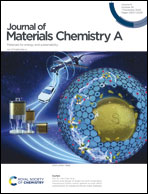Wearable super-adsorptive fibrous equipment in situ grafted with porous organic polymers for carcinogenic fumigant defense and detoxification†
Abstract
Highly porous nucleophilic organic polymers (Nu-POPs) were synthesized in situ on cotton fibers by a condensation reaction between cyanuric chloride and melamine, and the products were employed as robust, wearable, and flexible cotton-based super-adsorptive fibrous equipment (SAFE-cotton) against exposure to vaporous pesticides. The covalent growth of the Nu-POP on surfaces of cotton fibers retained the physical characteristics of the Nu-POP to the greatest extent, which include specific surface area and porosity, while the cotton fabrics still remained wearable. The SAFE-cotton can repeatedly adsorb fumigant vapors instantly (i.e., equilibrium is reached in one minute) and massively (i.e., methyl iodide adsorption capacity of 596.88 mg g−1). The nitrogen atoms in the triazine rings of the Nu-POP on the SAFE-cotton are nucleophilic to detoxify sequestered fumigants during long-term use and storage. A colorimetric signal could reveal the failure of the SAFE-cotton functions due to the detoxification of the fumigants and the formation of a conjugated structure of the Nu-POP. The success of achieving SAFE-cotton without significant loss of the Nu-POP performance in terms of rapid fumigant adsorption and detoxification is expected to guide the design of next-generation protective materials with the advantages of flexible, wearable and easily processible properties.



 Please wait while we load your content...
Please wait while we load your content...